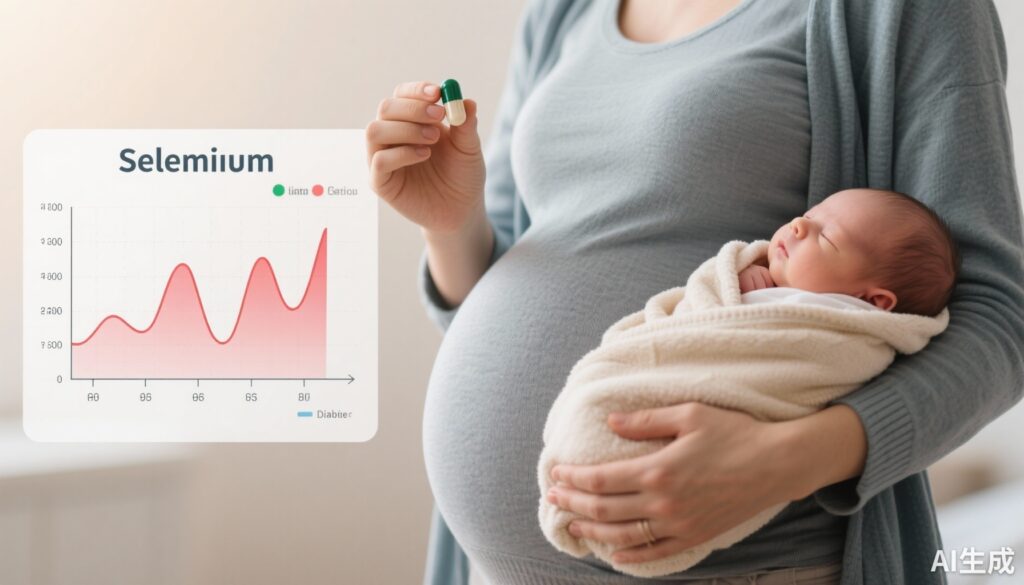Highlight
- Selenium supplementation at 200 µg/day significantly reduces fasting plasma glucose levels in women with gestational diabetes mellitus (GDM).
- Reduced incidence of newborn hyperbilirubinemia was observed with selenium supplementation.
- Selenium did not significantly impact insulin resistance as measured by HOMA-IR or lipid profiles including total cholesterol, triglycerides, LDL-C, and HDL-C.
- Current evidence draws from a limited number of randomized controlled trials, warranting cautious interpretation and need for further validation.
Study Background
Gestational diabetes mellitus (GDM) is a common metabolic disorder occurring during pregnancy, characterized by impaired glucose tolerance and variable degrees of insulin resistance, contributing to adverse maternal and neonatal outcomes. GDM prevalence is rising globally, with significant implications including increased risk of type 2 diabetes in mothers and metabolic disturbances in offspring. Optimal management of GDM remains challenging, involving lifestyle interventions and pharmacotherapy. Nutritional supplements, particularly antioxidants and trace elements like selenium, have drawn attention given their roles in glucose and lipid metabolism. Selenium is essential in antioxidant enzyme function and modulating inflammatory pathways, potentially beneficial in mitigating oxidative stress and metabolic dysregulation associated with GDM. However, clinical trial results on selenium supplementation efficacy in improving glycemic control and lipid metabolism in pregnant women with GDM remain inconsistent, prompting this systematic review and meta-analysis by Sun et al. to clarify the evidence base.
Study Design
This systematic review and meta-analysis included randomized controlled trials (RCTs) assessing the effects of selenium supplementation versus placebo in women diagnosed with GDM. A comprehensive search was conducted across multiple databases including PubMed, Cochrane Library, Web of Science, EMBASE, and Chinese databases up to May 2025. Four eligible RCTs comprising a total of 230 participants aged 18 to 45 years were included. Selenium supplementation doses ranged from 100 µg/day to 200 µg/day, with intervention durations spanning 6 to 12 weeks. Outcomes assessed included measures of glucose metabolism such as fasting plasma glucose (FPG) and homeostasis model assessment of insulin resistance (HOMA-IR), lipid parameters including total cholesterol, triglycerides, low-density lipoprotein cholesterol (LDL-C), and high-density lipoprotein cholesterol (HDL-C), and neonatal outcomes like hyperbilirubinemia incidence. Data extraction and risk of bias assessment followed Cochrane methodology, with meta-analyses conducted using random- or fixed-effects models as appropriate. Publication bias was evaluated via Begg and Egger tests.
Key Findings
The meta-analysis revealed that selenium supplementation at a daily dose of 200 µg was associated with a statistically significant reduction in fasting plasma glucose levels compared to placebo (mean difference [MD] = -5.03 mg/dL; 95% confidence interval [CI]: -7.70 to -2.37; P = 0.0002). This suggests a modest but meaningful improvement in glycemic control among pregnant women with GDM taking selenium supplements.
Contrastingly, selenium did not demonstrate a statistically significant effect on insulin resistance measured by HOMA-IR (MD = -0.71; 95% CI: -1.80 to 0.37; P = 0.20), indicating no clear benefit in improving peripheral insulin sensitivity based on the limited data available.
Regarding lipid metabolism, supplementation showed no significant changes in total cholesterol, triglycerides, LDL-C, or HDL-C levels compared to placebo, suggesting selenium’s effects may not extend substantially to lipid profile modulation in this population.
Notably, selenium supplementation was linked to a significant reduction in the incidence of newborn hyperbilirubinemia (risk difference = 0.09; 95% CI: 0.03 to 0.33; P = 0.0003), an important neonatal complication potentially related to oxidative stress or altered hepatic metabolism.
The safety profiles across studies reported no major adverse events attributable to selenium at the studied doses and durations.
Expert Commentary
This meta-analysis offers valuable synthesis supporting selenium’s potential as an adjunct intervention to modestly improve glycemic control and reduce neonatal complications in GDM, albeit with limitations. The small number of included RCTs and sample sizes reduces statistical power and limits subgroup analyses such as dose-response evaluation or stratification by baseline selenium status. Additionally, the heterogeneity of selenium doses and intervention durations challenges the generalizability of results. The lack of consistent impact on insulin resistance and lipid parameters could reflect either insufficient intervention duration or the complexity of metabolic regulation during pregnancy.
Mechanistically, selenium, a cofactor for glutathione peroxidase enzymes, may attenuate oxidative stress-mediated pancreatic β-cell dysfunction and inflammatory pathways, thereby improving glucose homeostasis. The neonatal benefit on hyperbilirubinemia might be linked to enhanced antioxidant protection in fetal liver tissue, reducing bilirubin accumulation.
Clinical guidelines currently do not recommend routine selenium supplementation in GDM, in part due to insufficient evidence and concerns over potential toxicity with excessive intake. This analysis underscores the need for larger, well-designed multicenter RCTs controlling for baseline selenium status, dietary intake, and genetic factors affecting selenium metabolism, to establish optimal dosing, safety, and efficacy profiles.
Conclusion
The current evidence from four RCTs suggests that selenium supplementation at 200 µg daily in pregnant women with GDM may improve fasting plasma glucose levels and reduce the risk of newborn hyperbilirubinemia without significant effects on insulin resistance or lipid profiles. These findings highlight a potential, albeit limited, role for selenium in gestational diabetes management. However, due to the small sample size and study limitations, these conclusions require cautious interpretation and validation through larger, rigorous clinical trials before clinical practice recommendations can be formulated.
Clinicians should continue to emphasize established GDM management strategies, including nutritional counseling, glycemic monitoring, and appropriate pharmacotherapy, while remaining attentive to emerging evidence on micronutrient supplementation. Selenium supplementation may represent a promising adjunct but should be considered only within the context of comprehensive clinical evaluation.
Funding and Clinical Trials Registration
The original meta-analysis by Sun et al. did not specify funding sources or clinical trials registration details. Future high-quality trials should adhere to rigorous reporting standards including trial registration and funding disclosures.
References
Sun J, Liu L, Shen J, Du J. Selenium supplementation for management of gestational diabetes mellitus in pregnancy: a systematic review and meta-analysis of randomized controlled trials. BMC Endocr Disord. 2025 Oct 10;25(1):226. doi: 10.1186/s12902-025-02045-5. PMID: 41073938; PMCID: PMC12513009.
American Diabetes Association. Standards of Medical Care in Diabetes—2024. Diabetes Care. 2024;47(Suppl 1):S1–S121.
Rayman MP. The importance of selenium to human health. Lancet. 2000;356(9225):233-241.



